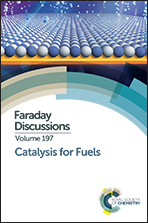In situ spectroscopic monitoring of CO2 reduction at copper oxide electrode
Abstract
Copper oxide modified electrodes were investigated as a function of applied electrode potential using in situ infrared spectroscopy and ex situ Raman and X-ray photoelectron spectroscopy. In deoxygenated KHCO3 electrolyte bicarbonate and carbonate species were found to adsorb to the electrode during reduction and the CuO was reduced to Cu(I) or Cu(0) species. Carbonate was incorporated into the structure and the CuO starting material was not regenerated on cycling to positive potentials. In contrast, in CO2 saturated KHCO3 solution, surface adsorption of bicarbonate and carbonate was not observed and adsorption of a carbonato-species was observed with in situ infrared spectroscopy. This species is believed to be activated, bent CO2. On cycling to negative potentials, larger reduction currents were observed in the presence of CO2; however, less of the charge could be attributed to the reduction of CuO. In the presence of CO2 CuO underwent reduction to Cu2O and potentially Cu, with no incorporation of carbonate. Under these conditions the CuO starting material could be regenerated by cycling to positive potentials.
- This article is part of the themed collection: Catalysis for Fuels

 Please wait while we load your content...
Please wait while we load your content...